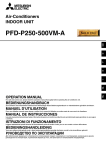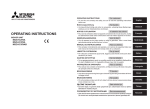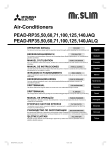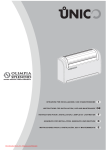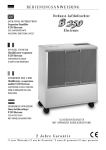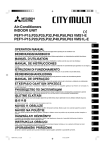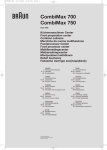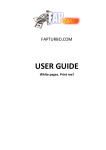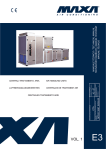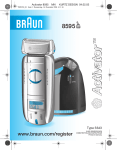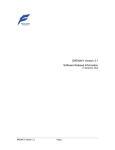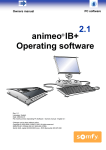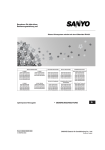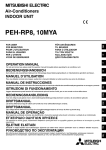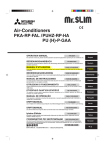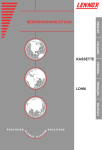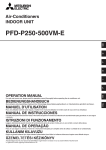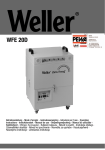Download Mitsubishi Electric PEFY-P VMH-E
Transcript
Air-Conditioners For Building Application INDOOR UNIT GB PEFY-P-VMH-E-F For safe and correct use, please read this operation manual thoroughly before operating the air-conditioner unit. D OPERATION MANUAL BEDIENUNGSHANDBUCH MANUEL D’UTILISATION F Zum sicheren und einwandfreien Gebrauch der Klimaanlage dieses Bedienungshandbuch vor Inbetriebnahme gründlich durchlesen. MANUAL DE INSTRUCCIONES E Pour une utilisation correcte sans risques, veuillez lire le manuel d’utilisation en entier avant de vous servir du climatiseur. ISTRUZIONI DI FUNZIONAMENTO I Lea este manual de instrucciones hasta el final antes de poner en marcha la unidad de aire acondicionado para garantizar un uso seguro y correcto. BEDIENINGSHANDLEIDING NL I Leggere attentamente questi istruzioni di funzionamento prima di avviare l’unità, per un uso corretto e sicuro della stessa. MANUAL DE OPERAÇÃO P Voor een veilig en juist gebruik moet u deze bedieningshandleiding grondig doorlezen voordat u de airconditioner gebruikt. Emniyetli ve do¤ru biçimde nas›l kullan›laca¤›n› ö¤renmek için lütfen klima cihaz›n› iflletmeden önce bu elkitab›n› dikkatle okuyunuz. RU TR IfiLETME ELK‹TABI CZ Для обеспечения правильного и безопасного использования следует ознакомиться с инструкциями, указанными в данном руководстве по эксплуатации, тщательным образом до того, как приступать к использованию кондиционера. SV РУКОВОДСТВО ПО ЭКСПЛУАТАЦИИ HG °È· ·ÛÊ¿ÏÂÈ· Î·È ÛˆÛÙ‹ ¯Ú‹ÛË, ·Ú·Î·Ï›ÛÙ ‰È·‚¿ÛÂÙ ÚÔÛ¯ÙÈο ·˘Ùfi ÙÔ ÂÁ¯ÂÈÚ›‰ÈÔ ¯Ú‹Ûˆ˜ ÚÈÓ ı¤ÛÂÙ Û ÏÂÈÙÔ˘ÚÁ›· ÙË ÌÔÓ¿‰· ÎÏÈÌ·ÙÈÛÌÔ‡. PO E°XEIPI¢IO O¢H°IøN XPH™Eø™ GR Para segurança e utilização correctas, leia atentamente o manual de operação antes de pôr a funcionar a unidade de ar condicionado. I Remote controller-Button Fernbedienungs-Taste Touche Commande à distance GB D F OFF ˚C STAND BY DEFROST ERROR CODE NOT AVAILABLE TEMP. FILTER CHECK MODE TEST RUN FUNCTION ON/OFF B 2 FILTER 3 CHECK TEST PAR-20MAA Bottone dell’unità del comando a distanza Controlador remoto-Botón Knop afstandbediening Botão do controlo remoto 1 Pulsante [Regolazione della temperatura ambiente] 2 Pulsante [Timer/continuo] 3 Pulsante [Selezione modalità di funzionamento] 4 Pulsante [Selezione ora] Pulsante [Impostazione dell’ora] ˚C CLOCK CHECK 1 P 1Hr. CENTRALLY CONTROLLED ON E NL A 0 TIMER SET 5 Pulsante [Regolazione deflettore] 6 Pulsante [Regolazione della velocità di ventilazione] 7 Pulsante [Regolazione della direzione di soffiaggio verso l’alto/il basso] 8 Pulsante [Ventilazione] 9 Pulsante [Controllo/Incorporata] 0 Pulsante [Prova di funzionamento] A Pulsante [Filtro] B Pulsante [ACCENSIONE/SPEGNIMENTO] C Posizione temperatura ambiente incorporata • Non esporre mai il comando a distanza alla luce diretta del sole, in quanto questo può alterare la corretta rilevazione della temperatura ambiente. • Non porre alcun ostacolo attorno alla sezione inferiore destra del comando a distanza, in quanto questo può alterare la corretta rilevazione della temperatura ambiente. C 4 5 6 87 9 1 [Room temperature adjustment] Button 1 Botón [Ajuste de la temperatura de la habitación] 2 [Timer/continuous] Button 2 Botón [Temporizador/continuo] 3 [Selecting operation] Button 3 Botón [Selección del modo de funcionamiento] 4 [Time selection] Button [Time-setting] Button 4 Botón [Selección de la hora] 5 [Louver] Button 5 Botón [Persiana] 6 [Fan speed adjustment] Button 6 Botón [Ajuste de la velocidad del ventilador] 7 [Up/down airflow direction] Button 7 Botón [Dirección de la corriente ascendente/descendente de aire] 8 [Ventilation] Button 9 [Checking/built-in] Button 8 Botón [Ventilación] 9 Botón [Comprobación/Incorporada] 0 [Test run] Button A [Filter] Button 0 Botón [Prueba de funcionamiento] A Botón [Filtro] B [ON/OFF] Button B Botón [ON/OFF] C Position of built-in room temperature C Posición de temperatura ambiente incorporada • Never expose the remote controller to direct sunlight. Doing so can result in the erroneous measurement of room temperature. • Nunca exponga el mando a distancia a la luz directa del sol. Si lo hace, se producirá una lectura errónea de la temperatura de la habitación. • Never place any obstacle around the lower right-hand section of the remote controller. Doing so can result in the erroneous measurement of room temperature. • Nunca ponga ningún obstáculo alrededor de la sección inferior derecha del mando a distancia. Si lo hace, se producirá una lectura errónea de la temperatura de la habitación. 1 Raumtemperatur-Tasten 1 [Aanpassen kamertemperatuur] Knop 2 Zeitschalter-/Dauerbetrieb-Taste 2 [Timer/continu] Knop 3 Betriebsart-Taste 3 [Standselectie] Knop 4 Zeitumschalt-Taste Zeiteinstell-Tasten 4 [Tijdselectie] Knop 5 Klappen-Taste 5 [Ventilatie-jaloezie] Knop 6 Luftstromgeschwindigkeit-Taste 6 [Aanpassen van de ventilatorsnelheid] Knop 7 Vertikale luftstromrichtung-Tasten 7 [Blaasrichting naar boven/ naar beneden] Knop 8 Belüftung-Tasten 9 Überprüfen/Eingebauten-Tasten 8 Knop [Ventilatie] 9 Knop [Controle/Ingebouwde] 0 Testlauf-Tasten A Filter-Taste 0 Knop [Proefdraaien] A [Filter] Knop B Betrieb-/Stop-Taste B [ON/OFF (AAN/UIT)] Knop C Position der eingebauten Raumtemperatur C Plaats van ingebouwde kamertemperatuursensor • Die Fernbedienung nicht direkter Sonneneinstrahlung aussetzen. Die Raumtemperatur wird sonst nicht korrekt gemessen. • Laat de afstandsbediening nooit in direct zonlicht liggen. Als u dit toch doet kan het zijn dat de kamertemperatuur onjuist gemeten wordt. • Den rechten unteren Teil der Fernbedienung nicht blockieren. Die Raumtemperatur wird sonst nicht korrekt gemessen. • Zet of hang nooit iets in de buurt van het gedeelte rechtsonder op de afstandsbediening. Als u dit toch doet kan het zijn dat de kamertemperatuur onjuist gemeten wordt. 1 Touche de [réglage de la température de la pièce] 1 Tecla de [regulação da temperatura da peça] 2 Touche de [fonctionnement continu/minuterie] 2 Tecla de [temporização/contínuo] 3 Touche de [sélection du mode de fonctionnement] 3 Tecla de [selecção de funcionamento] 4 Touche de [sélection de l’heure] 4 Tecla de [selecção da hora] Botón [Determinación de la hora] [Tijdinstellings] Knop Touche de [réglage de l’heure] Tecla de [programação da hora] 5 Touche de [pivotement] 5 Tecla [Veneziana] 6 Touche de [réglage de la vitesse du ventilateur] 6 Tecla de [regulação da velocidade da ventoinha] 7 Touche de [sens de la soufflerie vers le haut/vers le bas] 7 Tecla de [direcção do fluxo de ar para cima/para baixo] 8 Touche [Ventilation] 9 Touche [Vérification/Intégré] 8 Botão [Ventilação] 9 Botão [Verificação/Incorporada] 0 Touche [Essai de fonctionnement] A Touche de [filtre] 0 Botão [Teste de funcionamento] A Tecla [filtro] B Touche [ON/OFF] B Tecla [ON/OFF] (Ligar/Desligar) C Position du capteur intégré de la température de la pièce C Posição da temperatura ambiente incorporada • Ne jamais laisser la commande à distance en plein soleil sinon les données de température ambiante risquent d’être erronées. • Nunca exponha o controlo remoto à luz directa do sol, porque pode dar-lhe valores de temperatura da peça anormais. • Ne jamais placer d’obstacle devant la partie inférieure droite de la commande à distance sinon la lecture des températures ne sera pas correcte. • Nunca coloque nenhum obstáculo em volta da secção inferior direita do controlo remoto, pois isso pode dar-lhe valores de temperatura da peça anormais. 2 GR RU TR ∆ËϯÂÈÚÈÛÙ‹ÚÈÔ-∫Ô˘Ì› Кнопка контроллера ДУ Uzaktan kumanda ünitesi - Dü¤me CZ SV HG PO 1 ∫Ô˘Ì› [ƒ‡ıÌÈÛ˘ ıÂÚÌÔÎÚ·Û›·˜ ‰ˆÌ·Ù›Ô˘] 2 ∫Ô˘Ì› [ÃÚÔÓfiÌÂÙÚÔ/Û˘Ó¯‹˜] 4 ∫Ô˘Ì› [∂ÎÏÔÁ‹˜ ¯ÚfiÓÔ˘] 3 ∫Ô˘Ì› [∂ÎÏÔÁ‹˜ ÏÂÈÙÔ˘ÚÁ›·˜] ∫Ô˘Ì› [ÁÚ›ÏÏÈ·˜] 6 ∫Ô˘Ì› [ƒ‡ıÌÈÛ˘ Ù·¯‡ÙËÙ·˜ ·ÓÂÌÈÛÙ‹Ú·] 7 ∫Ô˘Ì› [¶¿Óˆ/οو ηÙ‡ı˘ÓÛ˘ ÚÔ‹˜ ·¤Ú·] 8 ∫Ô˘Ì› [∂Í·ÂÚÈÛÌÔ‡] 9 ∫Ô˘Ì› [∂ϤÁ¯Ô˘/ÂÓۈ̷و̤ÓÔ˘] 0 ∫Ô˘Ì› [¢ÔÎÈÌ·ÛÙÈ΋˜ ÏÂÈÙÔ˘ÚÁ›·˜] A ∫Ô˘Ì› [Ê›ÏÙÚÔ˘] B ∫Ô˘Ì› [ON/OFF] C £¤ÛË ÙÔ˘ ÂÓۈ̷و̤ÓÔ˘ ıÂÚÌfiÌÂÙÚÔ˘ ‰ˆÌ·Ù›Ô˘ • ªËÓ ÂÎÙ›ıÂÙ ÔÙ¤ ÙÔ ¯ÂÈÚÈÛÙ‹ÚÈÔ ÂÍ ·ÔÛÙ¿Ûˆ˜ ÛÙÔ ËÏÈ·Îfi ÊÒ˜. ∞˘Ùfi ÌÔÚ› Ó· ¤¯ÂÈ Û·Ó ·ÔÙ¤ÏÂÛÌ· Ï·Óı·Ṳ̂Ó˜ ÌÂÙÚ‹ÛÂȘ Ù˘ ıÂÚÌÔÎÚ·Û›·˜ ‰ˆÌ·Ù›Ô˘. • ªËÓ ÙÔÔıÂÙ›Ù ÔÙ¤ ÂÌfi‰È· Á‡Úˆ ·fi ÙÔ Î¿Ùˆ ‰ÂÍÈfi ÙÌ‹Ì· ÙÔ ¯ÂÈÚÈÛÙËÚ›Ô˘ ÂÍ ·ÔÛÙ¿Ûˆ˜. ∞˘Ùfi ÌÔÚ› Ó· ¤¯ÂÈ Û·Ó ·ÔÙ¤ÏÂÛÌ· Ï·Óı·Ṳ̂Ó˜ ÌÂÙÚ‹ÛÂȘ Ù˘ ıÂÚÌÔÎÚ·Û›·˜ ‰ˆÌ·Ù›Ô˘. 1 Кнопка [Регулирование температуры в помещении] 2 Кнопка [Таймер/постоянно] 4 Кнопка [Выбор времени] Кнопка [Выбор операции] D 3 GB ∫Ô˘Ì› [ƒ‡ıÌÈÛ˘ ÒÚ·˜] 5 Кнопка [Направления потока воздуха вверх/вниз] 8 Кнопка [Вентиляция] 9 Кнопка [Проверка/встроенного датчика] 0 Кнопка [Тестовый прогон] A Кнопка [Фильтр] B Кнопка [ВКЛ./ВЫКЛ.] C Позиция встроенного датчика температуры помещения • Никогда не подвергайте пульт дистанционного управления воздействию прямых солнечных лучей. Это может привести к неправильным замерениям температуры в помещении. • Никогда не помещайте какое-либо препятствие перед нижней правой секцией пульта дистанционного управления. Это может привести к неправильному замерению температуры в помещении. 1 [Oda S›cakl›¤› Ayar›] Dü¤mesi 2 [Saatli/Sürekli Çal›flma] Dü¤mesi 4 [Saat Seçme] Dü¤mesi E Кнопка [Регулировки скорости вентилятора] 7 I Кнопка [жалюзи] 6 F Кнопка [Настройка времени] 5 [Program Seçme] Dü¤mesi NL 3 [Havaland›rma] Dü¤me 9 [Kontrol/Entegre] Dü¤me 0 [Deneme Çal›flt›rmas›] Dü¤me A [Filtre] Dü¤mesi B [Açma/Kapama] Dü¤mesi C Entegre oda s›cakl›¤› konumu • Uzaktan kumanda ünitesini günefl ›fl›¤›na maruz b›rakmay›n. Aksi taktirde oda s›cakl›¤›n›n yanl›fl ölçülmesine neden olabilirsiniz. • Uzaktan kumanda ünitesinin sa¤ alt köflesinin önünü hiçbir flekilde kapatmay›n. Aksi taktirde oda s›cakl›¤›n›n yanl›fl ölçülmesine neden olabilirsiniz. GR [Hava Ak›m›n› Afla¤›/Yukar› Yönlendirme] Dü¤mesi 8 RU [Vantilatör H›z› Ayarlama] Dü¤mesi 7 TR [Pancur] Dü¤mesi 6 P [Saat Ayar›] Dü¤mesi 5 3 I Remote controller-Display Fernbedienung-Anzeige Affichage Commande à distance GB D F DC B ON OFF ˚C ERROR CODE NOT AVAILABLE F D GB TEMP. ON/OFF H Display dell’unità del comando a distanza Controlador remoto-Indicador Display afstandbediening Visualização do controlo remoto A Ora corrente/Timer B Comando centralizzato C Timer attivato D Si verifica un’anomalia E Modo funzionamento: F Preparazione della modalità di riscaldamento G Modalità di sbrinamento H Impostazione temperatura I Alimentazione attivata J Deflettore K Funzione non disponibile L Ventilazione M Modalità impostazione funzione N Modalità di prova di funzionamento O Modalità di controllo errore P Simbolo del filtro Q Impostazione effettiva di un’ora R Posizione del sensore S Temperature ambiente T Flujo de aire U Velocità di ventilazione COOL, DRY, AUTO, FAN, HEAT I KL J A Current time/Timer A Hora actual/Temporizador B Centralized control B Control centralizado C Timer ON C Temporizador en ON D Abnormality occurs D Se producen anomalías E Operation mode: E Modo de funcionamiento: F Preparing for Heating mode G Defrost mode H Set temperature I Power ON F Preparación para el modo Calefacción J Louver K Not available function G Modo Descongelación H Temperatura programada L Ventilation M Function setting mode I Activado J Rejilla N Test run mode O Error check mode K Función no disponible L Ventilación P Filter sign Q Set effective for 1 hr. M Modo de configuración de funciones N Modo de prueba de funcionamiento R Sensor position S Room temperature O Modo de comprobación de errores P Señal del filtro T Airflow U Fan speed Q Valor activado por una hora R Posición del sensor S Temperatura ambiente T Flusso d’aria U Velocidad del ventilador COOL, DRY, AUTO, FAN, HEAT REFRIGERACIÓN, DESHUMIDIFICACIÓN, VENTILADOR, AUTOMÁTICO, MODO CALEFACCIÓN TR RU GR P NL I E FILTER CHECK MODE TEST RUN FUNCTION ˚C STAND BY DEFROST G R P O N M 1Hr. CLOCK CHECK F P A UT Q S CENTRALLY CONTROLLED E E NL A Aktuelle Zeit/Timer (Zeitschalter) A Huidige tijd/Timer B Anzeige für Zentralsteuerung B Centraal regelen C Zeitschalter/Timer ON/EIN C Timer AAN D Auftretende Abnormität D Storing treedt op E Betriebsart: E Werkingsstand: F Vorbereitung zur Betriebsart Heizen G Betriebsart Enteisen H Eingestellten Temperatur I Netz ON/EIN F Bezig voor te bereiden op verwarmingsmodus J Luftklappe K Funktion nicht verfügbar G Ontdooimodus H Installen temperatuur L Ventilation M Betriebsart Funktion einstellen I Voeding AAN J Jalouzie N Betriebsart Testlauf O Betriebsart Fehlerprüfung K Niet-beschikbare functie L Ventileren P Filterzeichen Q 1 Stunde wirksame Einstellung M Functie-instellingsmodus N Proefdraaimodus R Fühlerposition S Raumtemperatur O Foutcontrolemodus P Filterteken T Luftstrom U Luftstromgeschwindigkeit Q Installen effectief voor na één uur R Plaats van sensor S Kamertemperatuur T Luchtstroom U Ventilatorsnelheid KÜHLEN, LUFTTROCKNEN, AUTO, GEBLÄSE, HEIZEN KOELEN, A Heure/Programmateur A Hora actual/Temporizador B Contrôle centralisé B Controlo centralizado C Programmateur activé (ON) C Temporizador ON (Ligado) D En cas d’anomalie D Ocorre uma anomalia E Mode de fonctionnement: E Modo de funcionamento: REFROIDDISSEMENT, AUTOMATIQUE, DESHUMIDIFICATION, SOUFFLERIE, DROGEN, AUTO, VENTILATOR, VERWARMEN CHAUFFAGE ARREFECIMENTO, VENTOINHA, DESCONGELAÇÃO, QUENTE F Préparation pour le mode chauffage G Mode dégivrage F Preparar para o modo de Aquecimento H Réglage de la température I Mise sous tension (ON) G Modo de Descongelação H Temperatura programada J Lucarne K Fonction non disponible I Corrente ON (Ligada) J Louver L Ventilation M Mode de réglage du fonctionnement K Função não disponível L Ventilação N Mode d’essai de fonctionnement O Mode de vérification des erreurs M Modo de programação de Função N Modo de teste de funcionamento P Signe du filtre Q Réglage après une heure O Modo de verificação de erro P Sinal do filtro R Position du capteur S Température de la pièce Q Em funcionamento durante uma hora R Posição do sensor T Flux d’air U Vitesse du ventilateur S Temperatura ambiente T Fluxo de Ar U Velocidade da ventoinha 4 AUTO, GR RU TR ∆ËϯÂÈÚÈÛÙ‹ÚÈÔ-∂›‰ÂÈÍË Дисплей контроллера ДУ Uzaktan kumanda ünitesi-Göstergesi CZ SV HG PO A ∆Ú¤¯Ô˘Û· ÒÚ·/ÃÚÔÓԉȷÎfiÙ˘ B ∫ÂÓÙÚÈÎÔ‡ ÂϤÁ¯Ô˘ C ÃÚÔÓԉȷÎfiÙ˘ √¡ D ¶·ÚÔ˘ÛÈ¿˙ÂÙ·È ·ÓˆÌ·Ï›· E º¿ÛË ÏÂÈÙÔ˘ÚÁ›·˜: æÀ•∏, ∞ºÀ°ƒ∞¡™∏, ∞¡∂ªπ™∆∏ƒ∞™, ∞À∆√ª∞∆∏ §∂π∆√Àƒ°π∞, £∂ƒª∞¡™∏ ¶ÚÔÂÙÔÈÌ·Û›· ÁÈ· ÙË ÏÂÈÙÔ˘ÚÁ›· ı¤ÚÌ·ÓÛ˘ G §ÂÈÙÔ˘ÚÁ›· ·fi„˘Í˘ H ƒ‡ıÌÈÛ˘ ıÂÚÌÔÎÚ·Û›·˜ I §ÂÈÙÔ˘ÚÁ›· √¡ J °Ú›ÏȘ K ªË ‰È·ı¤ÛÈÌË ÏÂÈÙÔ˘ÚÁ›· L ∂Í·ÂÚÈÛÌÔ‡ M ƒ‡ıÌÈÛË ÏÂÈÙÔ˘ÚÁ›·˜ N ∫·Ù¿ÛÙ·ÛË ‰ÔÎÈÌ·ÛÙÈ΋˜ ÏÂÈÙÔ˘ÚÁ›·˜ O ∫·Ù¿ÛÙ·ÛË ÂϤÁ¯Ô˘ ÛÊ·ÏÌ¿ÙˆÓ P ™‹Ì· Ê›ÏÙÚÔ˘ Q ƒ‡ıÌÈÛË ÈÛ¯‡ÂÈ ÁÈ· Ì›· ÒÚ· R £¤ÛË ·ÈÛıËÙ‹Ú· S £ÂÚÌÔÎÚ·Û›· ‰ˆÌ·Ù›Ô˘ T ƒÔ‹ ·¤Ú· U ∆·¯‡ÙËÙ·˜ ·ÓÂÌÈÛÙ‹Ú· A Текущее время/Таймер B Централизованного контроля C Таймер ВКЛ. (ON) D В случае неполадки E Режим эксплуатации: D GB F ОХЛАЖДЕНИЕ, СУШКА, АВТО, ВЕНТИЛЯТОР, ОБОГРЕВ Подготовка к режиму обогрева G Режим размораживания H Выбора температуры I Питание ВКЛ. (ON) J Заслонка K Функция недоступна L Вентиляции M Режим установки функции N Режим тестового прогона O Режим проверки ошибки P Символ фильтра Q Задействован в течение одного часа R Позиция датчика S Температура в помещении T Воздушный поток U Скорости вентилятора A Mevcut saat/Zamanlay›c› B Merkezi Kontrol Alt›nda C Zamanlay›c› AÇIK D Anormal durum olufltu. Buz giderme modu H ‹stenilen S›cakl›k I Elektrik AÇIK J Pancur K Kullan›lamayan fonksiyon L Havaland›rma M Fonksiyon ayarlama modu N Deneme çal›flt›rmas› modu O Hata kontrol modu P Filtre iflareti Q Bir Saat Boyunca Etkin K›lma R Sensör konumu S Oda s›cakl›¤› T Hava Ak›m› U Vantilatör H›z› KURUTMA, OTOMAT‹K, FAN, ISITMA P G SO⁄UTMA, GR Is›tma moduna haz›rl›k RU Programlama modu: F TR E NL I E F F 5 [Fig. A] <PEFY-P-VMH-E-F> A: Filter Filter Filtre Filtro Filtro Filter Filtro º›ÏÙÚÔ Фильтр Filtre A 6 : Air Flow Luftstrom Flux d’air Flujo de aire Flusso d’aria Luchtstroom Fluxo de Ar ƒÔ‹ ·¤Ú· Воздушный поток Hava Ak›m› Contents 1. Safety precautions ...................................................................................... 1.1. Installation ................................................................................. 1.2. During operation ........................................................................ 1.3. Disposing of the unit .................................................................. 2. Names and functions of various parts ........................................................ 3. How to operate ........................................................................................... 3.1. ON/OFF ..................................................................................... 3.2. Selecting operation .................................................................... 3.3. Room temperature adjustment .................................................. 7 7 7 8 8 8 8 8 9 4. 5. 6. 7. 8. 3.4. Time setting ............................................................................... 9 3.5. Timer setting .............................................................................. 9 3.6. Others ........................................................................................ 9 The smart way to use ............................................................................... 10 Caring for the machine ............................................................................. 10 Troubleshooting ......................................................................................... 10 Installation, transferring works, and checking ........................................... 11 Specifications ............................................................................................ 11 1. Safety precautions Caution: The outdoor unit should be installed in a location where air and noise emitted by the unit will not disturb the neighbours. 3) Remote controller Caution: Describes precautions that should be observed to prevent damage to the unit. Symbols used in the illustrations : Indicates an action that must be avoided. Warning: The remote controller should be installed in such a way that children cannot play with it. 4) Drain hose : Indicates that important instructions must be followed. : Indicates a part which must be grounded. : Indicates that caution should be taken with rotating parts. (This symbol is D Describes precautions that should be observed avoid to the risk of injury or death to the user. Warning: The indoor unit should be securely installed. If the unit is loosely mounted, it may fall, causing injury. F Warning: GB 2) Indoor unit Symbols used in the text Caution: Make sure that the drain hose is installed so that drainage can go ahead smoothly. Incorrect installation may result in water leakage, causing damage to furniture. E s Before operating the unit, make sure you read all the “Safety precautions”. s “Safety precautions” lists important points about safety. Please be sure to follow them. displayed on the main unit label.) <Color: yellow> <Color: yellow> • • • • • • • • The unit should not be installed by the user. Ask the dealer or an authorized company to install the unit. If the unit is installed improperly, water leakage, electric shock or fire may result. Use only accessories authorized by Mitsubishi Electric and ask your dealer or an authorized company to install them. If accessories are installed improperly, water leakage, electric shock or fire may result. The Installation Manual details the suggested installation method. Any structural alteration necessary for installation must comply with local building code requirements. Never repair the unit or transfer it to another site by yourself. If repair is performed improperly, water leakage, electric shock or fire may result. If you need to have the unit repaired or moved, consult your dealer. Keep the electric parts away from water (washing water) etc. It might result in electric shock, catching fire or smoke. Note1: When washing the Heat Exchanger and Drain Pan, ensure the Control Box, Motor and LEV remain dry, using a water proof covering. Note2: Never drain the washing water for the Drain Pan and the Heat Exchanger using the Drain Pump. Drain separately. The appliance is not intended for use by young children or infirm persons without supervision. Young children should be supervised to ensure that they do not play with the appliance. Do not use a leak detection additive. • The unit must be properly grounded. Never connect the grounding wire to a gas pipe, water pipe, lightning conductor or telephone grounding wire. If the unit is not grounded properly, electric shock may result. Check frequently that the ground wire from the outdoor unit is properly connected to both the unit’s ground terminal and the grounding electrode. Caution: • • • • • Do not use any sharp object to push the buttons, as this may damage the remote controller. Do not twist or tug on the remote controller cord as this may damage the remote controller and cause malfunction. Never remove the upper case of the remote controller. It is dangerous to remove the upper case of the remote controller and touch the printed circuit boards inside. Doing so can result in fire and failure. Never wipe the remote controller with benzene, thinner, chemical rags, etc. Doing so can result in discoloration and failure. To remove heavy stains, soak a cloth in neutral detergent mixed with water, wring it out thoroughly, wipe the stains off, and wipe again with a dry cloth. Never block or cover the indoor or outdoor unit’s intakes or outlets. Tall items of furniture underneath the indoor unit, or bulky items such as large boxes placed close to the outdoor unit will reduce the unit’s efficiency. Warning: 1) Outdoor unit Warning: • • The outdoor unit must be installed on a stable, level surface, in a place where there is no accumulation of snow, leaves or rubbish. Do not stand on, or place any items on the unit. You may fall down or the item may fall, causing injury. NL I 1.2. During operation • • • Do not splash water over the unit and do not touch the unit with wet hands. An electric shock may result. Do not spray combustible gas close to the unit. Fire may result. Do not place a gas heater or any other open-flame appliance where it will be exposed to the air discharged from the unit. Incomplete combustion may result. 7 TR • • RU Caution: Warning: GR 6) Grounding GB safe place for easy reference whenever a question arises. If the unit is going to be operated by another person, make sure that this manual is given to him or her. P s After you have read this manual, keep it and the Installation Manual in a GB 1.1. Installation • • Make sure that the unit is powered by a dedicated supply. Other appliances connected to the same supply could cause an overload. Make sure that there is a main power switch. Be sure to adhere to the unit’s voltage and fuse or circuit breaker ratings. Never use a piece of wire or a fuse with a higher rating than the one specified. GB Carefully read the labels affixed to the main unit. Warning: • GB Warning: I 5) Power line, fuse or circuit breaker GB : Beware of electric shock. (This symbol is displayed on the main unit label.) Warning: • • • • • • Do not remove the front panel or the fan guard from the outdoor unit when it is running. You could be injured if you touch rotating, hot or highvoltage parts. Never insert fingers, sticks etc. into the intakes or outlets, otherwise injury may result, since the fan inside the unit rotates at high speed. Exercise particular care when children are present. If you detect odd smells, stop using the unit, turn off the power switch and consult your dealer. Otherwise, a breakdown, electric shock or fire may result. When you notice exceptionally abnormal noise or vibration, stop operation, turn off the power switch, and contact your dealer. Do not over-cool. The most suitable inside temperature is one that is within 5 °C of the outside temperature. Do not leave handicapped people or infants sitting or standing in the path of the airflow from the air-conditioner. This could cause health problems. • • When the air conditioner is not to be used for a long time • • Caution: GB • • Do not direct the airflow at plants or caged pets. Ventilate the room frequently. If the unit is operated continuously in a closed room for a long period of time, the air will become stale. • In case of failure D F Never remodel the air conditioner. Consult your dealer for any repair or service. Improper repair work can result in water leakage, electric shock, fire, etc. If the remote controller displays an error indication, the air conditioner does not run, or there is any abnormality, stop operation and contact • 2. Names and functions of various parts Warning: When you need to dispose of the unit, consult your dealer. If pipes are removed incorrectly, refrigerant (fluorocarbon gas) may blow out and come into contact with your skin, causing injury. Releasing refrigerant into the atmosphere also damages the environment. Attachment and detachment of filter Caution: E • [Fig. A] (P.6) 3.1. ON/OFF A Start an operation 1. Press the B [ON/OFF] button Operation lamp V lights up and operation starts. C P CENTRALLY CONTROLLED ON E 1Hr. OFF ˚C ERROR CODE TEMP. GR Stop an operation ˚C CLOCK CHECK STAND BY DEFROST NOT AVAILABLE FILTER CHECK MODE TEST RUN FUNCTION 1. Press the B [ON/OFF] button again Operation lamp goes off and operation stops. ON/OFF 1 B • During operation, the operation lamp above the [ON/OFF] button lights up. TIMER SET RU PAR-20MAA Caution: 4 TR Once the buttons have been set, pressing of the [ON/OFF] button will only repeat the same operation thereafter. A 3 CHECK TEST GB • FILTER 2 6 87 Even if the operation button is pressed immediately after the operation is stopped, operation will not restart for about 3 minutes. This function protects the machine. It automatically starts operation after the lapse of approximately 3 minutes. Before starting operation 3.2. Selecting operation • When selecting operation • GB GB GB In removing the filter, precautions must be taken to protect your eyes from dust. Also, if you have to climb up on a stool to do the job, be careful not to fall. Turn off the power supply when the filter is changed. 3. How to operate NL I • • GB If the air conditioner is not to be used for a long time due to a seasonal change, etc., run it for 4 - 5 hours with the air blowing until the inside is completely dry. Failing to do so can result in the growth of unhygienic, unhealthy mold in scattered areas throughout the room. When it is not to be used for an extended time, keep the [power supply] turned OFF. If the power supply is kept on, several watts or several tens of watts will be wasted. Also, the accumulation of dust, etc., can result in fire. Keep the power switched ON for more than 12 hours before starting operation. Do not turn the power supply OFF during seasons of heavy use. Doing so can result in failure. 1.3. Disposing of the unit Warning: • your dealer. Leaving the unit as it is under such conditions can result in fire or failure. If the power breaker is frequently activated, get in touch with your dealer. Leaving it as it is can result in fire or failure. If the refrigeration gas blows out or leaks, stop the operation of the air conditioner, thoroughly ventilate the room, and contact your dealer. Leaving the unit as it is can result in accidents due to oxygen deficiency. • Start running after the “H0” display has disappeared. The “H0” display briefly appears on the room temperature display (max. 3 minutes) when the power is turned on and after a power failure. This does not indicate any failure of the air conditioner. The operation modes of the indoor units’ cooling operation and heating operation are different from those of the outdoor units. When the operation is started with cooling (heating) and other indoor units connected to the counterpart outdoor units are already running in the same operation mode, the remote control displays “ ” (“ ”) mode. However, the operation comes to stop, and you cannot get a desired mode. When this occurs, you will be notified by the “ ” (“ ”) display that flashes in the liquid crystal display of the remote controller. Set to the operation mode of other indoor unit by the operation switch button. The above does not apply to the models that simultaneously run both the cooling operation and heating operation. The outdoor units stop when all the indoor units connected to the counterpart outdoor units stop. During heating operation, even if the indoor unit is set to operation while the outdoor unit is in defrosting operation, operation starts after the defrosting operation of the outdoor unit has ended. 8 1. Press the 3 [selecting operation] button Consecutive pressing of the selecting operation button switches the operation over to E “ ”, “ ”, (“ ”), and (“ ”). For the contents of operation, check the display. For cooling Press the 3 [selecting operation] button and bring up the “ ” display. For fan Press the 3 [selecting operation] button and bring up the “ • The fan operation functions to circulate the air in the room. • The temperature of the room cannot be set by fan operation. ” display. Caution: Never expose your body directly to cool air for a long time. Excessive exposure to cool air is bad for your health, and should therefore be avoided. For heating Press the 3 [selecting operation] button to bring up the “ ” display. Off-timer Use the off-timer as a reminder to turn off the air conditioner. When the set endwork time arrives, the air conditioner stops operation. Regarding displays during heating operation “DEFROST” Displayed only during the defrosting operation. There are three methods for using the timer. “STAND BY” Displayed from the start of heating operation until the moment warm air blows out. 1. ON/OFF Timer When setting both starting and ending time 2. On-timer When only setting the starting time (Ending time is set to “ - - : - - ”) 3. Off-timer When only setting the ending time (Starting time is set to “ - - : - - ”) Caution: • • When the air conditioner is used together with burners, thoroughly ventilate the area. Insufficient ventilation can result in accidents due to oxygen deficiency. Never place a burner at a place where it is exposed to the airflow from the air conditioner. Doing so can result in imperfect combustion of the burner. Display example of timer setting ON OFF ON OFF 3.3. Room temperature adjustment To change room temperature The example shows a timer set for operation start at 8:00 and end at 17:00. It can be set regardless of the operation of the indoor unit. • During the time operation, the time-setting button becomes void, disabling time setting. 1. Press the 4 [time selection] button and bring up the A “current time” display Every time it is pressed, the display changes. OFF “current “timer start ON CLOCK time” time” “timer end time” • (no display) Release 2. Set the current time by pressing the 4 or • While the A “CLOCK” time is displayed, press the time setting 4 buttons and set the time. The setting advances one minute every time the 4 once, and retrogresses one minute every time the 4 once. CENTRALLY CONTROLLED STAND BY DEFROST The time cannot be set while the C “timer on” is displayed. • 3.6. Others button • / button is pressed button is pressed CHECK NOT AVAILABLE When respective 4 / buttons are pressed continuously, the time display goes fast forward. It advances in the order of 1 minute unit - 10 minute unit - one hour unit. • About 10 seconds after the button operation has been completed, the C “current time” and A “CLOCK” displays disappear. • Remote controller is equipped with a simplified clock with a precision of about + or - one minute per month. The time must be readjusted (reset) every time the air conditioner is subjected to a power stop of the air conditioner or a power failure. Caution: • GB : Displayed when control is executed by a separately sold centralized control unit, etc. : Displayed from the start of heating operation until the moment warm air blows out. : This displays indication when some abnormality occurs in the unit. : When a button is pressed for any function which the indoor unit cannot perform, this display flashes concurrently with the display of that function. : In the system in which the [Sensor] display is indicated as the “remote controller”, room temperature measurement is performed by the room temperature sensor built into the remote controller. Therefore, pay attention to the following: FILTER D ” display. P Caution: E Every time the 4 ( ) button of the 4 [timer selection] is pressed once, it advances (or retrogresses) by 10 minutes. If the button is pressed continuously, it advances (or retrogresses) continuously. First set the hour digit and then set the minute digit. When the ON/OFF timer mode is set, you can run (on-timer) or stop (off-timer) operation by pressing the B [ON/OFF] button even when there is remaining time. Press the 2 [timer/continuous] button and disappear the “ When the current time is not yet set, the “CLOCK (current time)” display flashes, disabling the setting of timer operation. ” display I • 6. Press the 2 [timer/continuous] button and bring up the C “ ” display completes the setting. Bringing up the C “ NL I Set the current time after turning ON the power of the air conditioner or after restoration from a power failure. ( ) button of the [time switch] and set the ending 5. Press the 4 time When using it as an on-timer, set the ending time to “ - - : - - ”. The “ - - : - - ” is displayed next to 23:50. GR 3.4. Time setting 4. Press the 4 [time selection] button and bring up the A “Timer end time” display : Displayed when it is time to clean the filter. Press the A [Filter] button twice, then the display is disappeared. RU The range of room temperature display is 8 - 39 °C. Outside this range, the display flashes either 8 - 39 °C to inform you if the room temperature is lower or higher than the displayed temperature. TR It is impossible to set the room temperature by the air-blow operation. * F 3. Press the 4 ( ) button of the 4 [time selection] and set the starting time When using it as an off-timer, set the starting time to “ - - : - - ”. The “ - - : - - ” is displayed next to 23:50. Indoor temperature can be set within the following range. Cooling/dry: 19 - 30 °C Heating: 17 - 28 °C • • 2. Press the 4 [time selection] button and bring up the A “Timer start time” display GB • 1. Press the 2 [timer/continuous] button and bring up the C no display GB Press the 1 [room temperature adjustment] button and set the room temperature of your choice. or once changes the setting by 1 °C. Pressing If the pressing is continued, the setting continues to change by 1 °C. If the timer is set, the unit starts (stops) at the set time, and the time mode is terminated. • When you wish to confirm the starting and ending time, press the 4 [time ” is displayed. selection] button while C “ GB • GB 3.5. Timer setting Function of timer GB On-timer Set the on-timer for the time the working day begins in your company. When the set start time arrives, the air conditioner starts operation. 9 4. The smart way to use Even minimal steps to care for your air conditioner can help make its use far more effective in terms of air-conditioning effect, electricity charges, etc. Clean the filter thoroughly • Set the right room temperature • In cooling operation, a temperature difference of about 5 °C between indoors and outdoors is optimum. • If the room temperature is raised by 1 °C during air-cooling operation, about 10 % electric power can be saved. • Excessive cooling is bad for health. It also results in the waste of electric power. If the screen of the air filter becomes clogged, the airflow and air-conditioning effect can be significantly reduced. Further, if the condition is left unattended, failure can result. It is particularly important to clean the filter at the beginning of the cooling and heating seasons. (When profuse dust and dirt have accumulated, clean the filter thoroughly.) Prevent intrusion of heat during air-cooling • To prevent the intrusion of heat during cooling operation, provide a curtain or a blind on the window to block out direct sunlight. Also, do not open the entrance or exit except in cases of dire necessity. 5. Caring for the machine How to clean • Clear dust away lightly or clean it up with a vacuum cleaner. In the case of severe staining, wash the filter in lukewarm water mixed with dissolved neutral detergent or water, and then rinse off the detergent completely. After washing, dry it and fix it back into place. • Do not dry the filter by exposing it to direct sunlight or warming it using fire, etc. Doing so can result in the deformation of the filter. Washing it in hot water (more than 50 °C) can also result in deformation. Caution: • • • Before you start cleaning, stop operation and turn OFF the power supply. Remember that the fan is rotating inside at high speed, posing a serious risk of injury. Indoor units are equipped with filters to remove the dust of sucked-in air. Clean the filters using the methods shown in the following sketches. (The standard filter should normally be cleaned once a week, and the long-life filter at the beginning of each season.) The life of the filter depends on where the unit is installed and how it is operated. Caution: • Caution: Never pour water or flammable sprays onto the air conditioner. Cleaning using these methods can result in the failure of the air conditioner, electric shock, or fire. E F D GB Always have filter maintenance performed by a service person. Before care-taking, turn the power supply OFF. I 6. Troubleshooting Before you ask for repair service, check the following points: NL State of Machine It does not run. Remote Controller “'” display is not lit up No display appears even when the [ON/OFF] button is pressed. Cause Power failure The power supply is turned OFF. The fuse in the power supply is gone. The earth leakage breaker is gone. P Improper temperature adjustment The liquid crystal display shows that it is in the state of operation. RU GR Air flows out but it does not cool enough or heat enough. The liquid crystal display shows that it is in operation. TR Cool air or warm air does not come out. GB It runs briefly, but soon stops. GB GB GB The sound of the exhaust and rotation of the motor can still be heard after stop of running. The sound of the exhaust and the rotation of the motor can be heard intermittently after stop of running. Warm air comes out intermittently when the thermostat is OFF or during fan operation. GB • The “check” and check code flashes on the liquid crystal display. The filter is filled with dust and dirt. There are some obstacles at the air inlet and outlet of the indoor and outdoor units. Windows and doors are open. The restart-preventing circuit is in operation for 3 minutes. Indoor unit operation was restarted during the heating and defrosting operation. There are some obstacles at the air inlet and outlet of the indoor and outdoor units. Troubleshooting Press the [ON/OFF] button after power restoration. Turn the power supply ON. Replace fuse. Put in the earth leakage breaker. After checking the set temperature and inlet temperature on the liquid crystal display, refer to [Room temperature adjustment], and operate the adjustment button. Clean up the filter. (Refer to [Caring for the machine].) Remove. Close. Wait for a while. (To protect the compressor, a 3-minute restart-preventing circuit is built into the indoor unit. Therefore, there are occasions sometimes when the compressor does not start running immediately. There are cases when it does not run for as long as 3 minutes.) Wait for a while. (Heating operation starts after ending defrosting operation.) Rerun after removal The filter is filled with dust and dirt. Rerun after cleaning the filter. (Refer to [Caring for the machine].) All lights are out except the powered display of “'”. When other indoor units are engaged in cooling operation, the machine stops after running a drain-up mechanism for 3 minutes when air-cooling operation is stopped. Wait for 3 minutes. All lights are out except the powered display of “'”. When other indoor units are engaged in cooling operation, drained water is brought in. If the drain water is collected, the drain-up mechanism initiates a draining operation. It soon stops. (If the noise occurs more than 2-3 times in an hour, ask for repair service.) The liquid crystal display shows that it is in the state of operation. When other indoor units are engaged in heating operation, the control valves are opened and closed from time to time to maintain the stability of the system. It soon stops. (If the room temperature rises uncomfortably high in a small room, stop operation.) If operation stops due to a power failure, the [restart-preventing circuit at power failure] operates and disables unit operation even after power restoration. In this case, press the [ON/OFF] button again and start operation. If malfunctions persist after you have checked the above, turn the power supply OFF and contact your dealer with information about the product name, the nature of the malfunction, etc. If the display of “[check]” and (4 digit) check code flashes, tell the dealer contents of the display (check code). Never attempt to repair by yourself. 10 The following symptoms are not air conditioner failures: • The air blown out from the air conditioner can sometimes give off odors. This is due to cigarette smoke contained in the air of the room, the smell of cosmetics, the walls, furniture, etc., absorbed in the air conditioner. • A hissing noise can be heard immediately after the air conditioner is started or stopped. This is the sound of the refrigeration flowing inside the air conditioner. This is normal. • The air conditioner sometimes snaps or clicks at the beginning or end of cooling/heating operation. This is the sound of friction on the front panel and other sections due to expansion and contraction caused by temperature change. This is normal. 7. Installation, transferring works, and checking Regarding transfer of installation • Caution: Never install the air conditioner where there is a risk of leakage of flammable gas. If gas leaks and accumulates around the unit, fire can result. Caution: where there is a lot of machine oil • near the ocean and beach areas where there is salt air. Regarding noise • where humidity is high • • where there are hot springs nearby In installing work, choose a place that can fully bear the weight of the air conditioner, and where noise and vibration can be reduced. • where there is sulphurous gas • Choose a place where cool or warm air and noise from the outdoor air outlet of the air conditioner does not inconvenience the neighbors. • where there is a high-frequency processing machinery (a high-frequency welder, etc.) • • where acid solution is frequently used If any alien object is placed near the outdoor air outlet of the air conditioner, decreased performance and increased noise can result. Avoid placing any obstacles adjacent to the air outlet. • where special sprays are frequently used • If the air conditioner produces any abnormal sound, consult with your dealer. • Install the indoor unit horizontally. Otherwise, water leakage can result. • Take sufficient measures against noise when installing the air conditioners at hospitals or communication-related businesses. Maintenance and inspection • If the air conditioner is used throughout several seasons, the insides can get dirty, reducing the performance. Depending upon the conditions of usage, foul odors can be generated and drainage can deteriorate due to dust and dirt, etc. I If the air conditioner is used in any of the above-mentioned environments, frequent operational failure can be expected. It is advisable to avoid these types of installation sites. For further details, consult with your dealer. D • GB When moving or reinstalling the air conditioner, consult with your dealer. Defective installation can result in electric shock, fire, etc. F Never install the air conditioner at the following place: When removing and reinstalling the air conditioner when you enlarge your home, remodel, or move, consult with your dealer in advance to ascertain the cost of the professional engineering work required for transferring the installation. E Regarding place for installation Consult with your dealer for details on installation and transferring the installation. Regarding electrical work • P The electrical work must be undertaken by a person who is qualified as an electrical engineer according to the [technical standard respecting electrical installation], [internal wiring rules], and the installation instruction manual with the absolute use of exclusive circuits. The use of other products with the power source can result in burnt-out beakers and fuses. Never connect the grounding wire to a gas pipe, water pipe, arrester, or telephone grounding wire. For details, consult with your dealer. In some types of installation sites, the installation of an earth leakage breaker is mandatory. For details, consult with your dealer. GR • NL I Caution: • RU 8. Specifications PEFY-P-VMH-E-F series GB GB TR P80VMH-E-F P140VMH-E-F ~220-240V 50Hz, ~208-230V 60Hz 9.0/8.5 16.0/15.1 380/1,000/900 380/1,200/900 50 70 9 18 40/115/190 50/115/190 50/130/210 60/130/220 80/170/220 100/170/240 35/85/170 35/85/170 40/115/190 50/115/190 50/130/220 60/130/220 27/38/43 28/38/43 33/43/45 34/43/45 Long life filter (option) GB Model Item Power source Cooling capacity*1 / Heating capacity*1 kW Dimension Height / Width / Depth mm Net weight kg Airflow rate (High) m3/min Fan External static 220 V 50 Hz Pa pressure 230 V 50 Hz 240 V 50 Hz 208 V 60 Hz 220 V 60 Hz 230 V 60 Hz Noise level 208 V, 220 V dB(A) (High)*2 230 V, 240 V Filter GB GB Notes: *1 Cooling/Heating capacity indicates the maximum value at operation under the following condition. Cooling: Indoor: 33 °C DB/28 °C WB Outdoor: 33 °C DB Heating: Indoor: 0 °C DB/-2.9 °C WB Outdoor: 0 °C DB/-2.9 °C WB *2 The operating noise is the data that was obtained in an anechoic room. 11 This product is designed and intended for use in the residential, commercial and light-industrial environment. The product at hand is based on the following EU regulations: • • Low Voltage Directive 73/23/EEC Electromagnetic Compatibility Directive 89/ 336/EEC Please be sure to put the contact address/telephone number on this manual before handing it to the customer. HEAD OFFICE: MITSUBISHI DENKI BLDG., 2-2-3, MARUNOUCHI, CHIYODA-KU, TOKYO 100-8310, JAPAN WT04312X02 Printed in Japan












